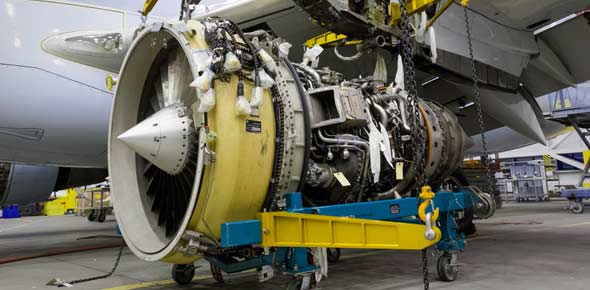(221) What will happen to the paint coating if you hold a spray gun...
(216) At a minimum, material data safety sheets (MSDS) are made...
(214) The paint edges around the chemically stripped areas are...
(228) What is used to wipe down the aircraft surface before applying...
(217) What must you do before you can wear a respirator with a...
(217) How often should a respirator be cleaned and disinfected?
(221) When using parallel strokes with a spray gun, the spray pattern...
(218) The type of chemical remover to be used depends on the
(218) When do you mix chemical paint remover?
(220) When using the plastic media blasting (PMB) cabinet blaster,...
(223) What is the most common cause of coating failure?
(226) What do you do with jelled or lumpy coating materials?
(209) Which scale is used to measure the strength of an electrolyte?
(202) Which secure web application is used to view electronic...
(209) Some metals have the ability to become electrochemically...
(222) What should the temperature be when mixing a touch-up pen paint...
(212) How often do you inspect water entrapment areas?
(212) Corrosion that appears as blistering, exfoliation, and scaling...
(201) What two categories are Air Force publications divided into?
(213) When removing corrosion with a pneumatic sander, how do you keep...
(215) The two categories that corrosion preventive compounds (CPC) are...
(230) Which component, of a computerized stencil system, cuts stencils...
(211) When performing a corrosion inspection, which tool would you use...
(213) What is the first step when using abrasive blasting to remove...
(214) When should you apply chemical conversion coating to metal?
(228) How long should you let the edge sealer dry before painting?
(210) Which type of corrosion is produced by the simultaneous effects...
(220) What is the first step when preparing a part to blast in the...
(224) The qualified products list (QPL)
(227) When should specialty walkway coatings be applied to the...
(208) An atom that has gained or lost electrons and has acquired an...
(221) The distance that the spray gun nozzle is held from the surface...
(211) Which formula would you use to determine maximum corrosion pit...
(222) Prior to use, how many seconds should a touch-up pen paint...
(204) The Maintenance Integrated Data Access System (MIDAS) is
(210) What is an advanced form of Inter-granular corrosion?
(229) What color do you paint service, ground handling and hazard...
(219) What special requirement(s) must be met when mechanically...
(222) You probably would not use a paint roller when painting aircraft...
(212) When inspecting spot welds for corrosion, which tool can be used...
(212) What is the first step of a general corrosion inspection?
(204) Which technical order (TO) contains operational checkout...
(213) Which motion should you use when removing corrosion with a hand...
(231) A rapid way of preparing a sign is by
(216) How many gallons of hazardous waste is the maximum amount you...
(221) What is the maximum nozzle pressure of a high volume low...
(223) What is a cause of orange peel when spray painting?
(212) Prior to corrosion removal, what must be determined?
(213) Material compatibility refers to using a medium that will
(215) Corrosion preventive compounds (CPC) are used to prevent
(231) After a decal is applied to an aircraft, what protects it...
(212) Corrosion that appears as blisters and pitting as deep as 0.010...
(209) What is the rate of corrosion when the anode is smaller, in...
(206) A revision to a publication is normally issued when the changes...
(223) What is a common cause of streaking when spray painting?
(203) How many groups of numbers may be used in a technical order (TO)...
(226) Which cup is preferred for measuring the viscosity of high-solid...
(210) On a polished surface, uniform surface corrosion is first seen...
(210) Pitting corrosion of aluminum or magnesium is first noticed as
(223) How would you correct a heavy center spray pattern defect?
(202) Which type of time compliance technical order (TCTO) is...
(209) Metals such as stainless steel and titanium that corrode slowly...
(208) Corrosion in an electrochemical cell always starts at the
(207) Which Air Force technical order (AFTO) form is used to correct...
(227) What is the general top coating sequence for small aircraft-tail...
(230) What must you do before you can use a stencil?
(212) When inspecting exhaust paths for corrosion, what areas should...
(225) Alkyd enamels and acrylic lacquers are considered what type of...
(228) During rain erosion resistant tape application, what is the...
(231) Which type of tape is used to affix large or intricately shaped...
(201) Informational publications which normally are "how to" documents...
(216) How high can you stack drums containing flammable liquids?
(219) What should you use to remove dust during mechanical paint...
(226) After checking the shelf life of your coating material what...
(223) Using an improper thinner causes
(224) Specific standards for paint such as color, drying time, and...
(221) When should you dismantle a spray gun?
(213) What is the last step in the general corrosion removal...
(206) Safety and operational supplements to technical orders (TO)...
(201) What is an example of a directive publication?
(229) Where is the national star insignia located on fixed-wing...
(202) Which is not one of the five major types of technical orders...
(205) Which technical order (TO) series is the illustrated parts...
((205) Which section of the illustrated parts breakdown (IPB) can you...
(225) Which type of walkway coating material is undesirable because of...
(212) Which type of corrosion should you look for when inspecting...
(229) Where are the USAF markings placed on aircraft?
(207) Which technical order (TO) should you use when filling out a...
(202) Which technical order (TO) category includes the inspection work...
(225) Which type of polyurethane coating is used on aerospace weapons...
















